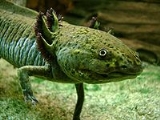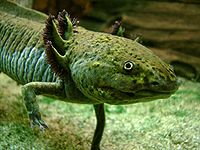
External gills
Encyclopedia
External gills are the gills of an animal, most typically an amphibian, that are exposed to the environment, rather than set inside the pharynx
and covered by gill slits, as they are in most fishes. Instead, the respiratory organs are set on a frill of stalks protruding from the sides of an animals head. This type of gill is most commonly observed on the aquatic larva of most species of salamanders, lungfish
This type of gill is most commonly observed on the aquatic larva of most species of salamanders, lungfish
, and bichir
s (which have only one large pair), and are retained by neotenic adult salamanders and some species of adult lungfish. They are present on non-transforming salamander species such as the mudpuppy
, as well as most members of the Proteidae and Sirenidae families, which naturally never metamorphose into an air-breathing form. The embryos of frogs and caecilians also develop external gills at some point in their development, though these are either resorbed before or disappear shortly after hatching. Fossils of the distant relatives of modern amphibians, such as Branchiosaurus
and Apateon
, also show evidence of external gills.
The external gills commonly consist of a single stalk (rami) protruding from a gill arch behind the head of the animal, above an associated gill slit. The stalk usually contains muscle tissue, and may be moved by the animal as a free appendage, in order to stir up stagnant water. The stalk is lined by many thinly walled filaments (fimbriae), containing the majority of blood vessels used in gas exchange. Animals usually have one external gill originating on each gill arch (except the hyoid), which leads to there being three pairs of external gills in salamanders, and four in the gilled larvae of lungfish.
Pharynx
The human pharynx is the part of the throat situated immediately posterior to the mouth and nasal cavity, and anterior to the esophagus and larynx. The human pharynx is conventionally divided into three sections: the nasopharynx , the oropharynx , and the laryngopharynx...
and covered by gill slits, as they are in most fishes. Instead, the respiratory organs are set on a frill of stalks protruding from the sides of an animals head.

Lungfish
Lungfish are freshwater fish belonging to the Subclass Dipnoi. Lungfish are best known for retaining characteristics primitive within the Osteichthyes, including the ability to breathe air, and structures primitive within Sarcopterygii, including the presence of lobed fins with a well-developed...
, and bichir
Bichir
The bichirs are a family, Polypteridae, of archaic-looking ray-finned fishes, the sole family in the order Polypteriformes.All species occur in freshwater habitats in tropical Africa and the Nile River system, mainly swampy, shallow floodplains and estuaries.-Anatomy and appearance:Bichirs are...
s (which have only one large pair), and are retained by neotenic adult salamanders and some species of adult lungfish. They are present on non-transforming salamander species such as the mudpuppy
Mudpuppy
Mudpuppies or waterdogs are aquatic salamanders of the family Proteidae. Their name originates from the misconception that they make a dog-like barking sound. The range of the genus Necturus runs from southern central Canada, through the midwestern United States, east to North Carolina and south to...
, as well as most members of the Proteidae and Sirenidae families, which naturally never metamorphose into an air-breathing form. The embryos of frogs and caecilians also develop external gills at some point in their development, though these are either resorbed before or disappear shortly after hatching. Fossils of the distant relatives of modern amphibians, such as Branchiosaurus
Branchiosaurus
Branchiosaurus is a genus of small, lightly built early prehistoric amphibians. Fossils have been discovered in strata dating from the late Pennsylvanian Epoch to the Permian Period...
and Apateon
Apateon
Apateon is an extinct genus of temnospondyl amphibian within the family Branchiosauridae.-References:* Gaining Ground: The Origin and Early Evolution of Tetrapods...
, also show evidence of external gills.
The external gills commonly consist of a single stalk (rami) protruding from a gill arch behind the head of the animal, above an associated gill slit. The stalk usually contains muscle tissue, and may be moved by the animal as a free appendage, in order to stir up stagnant water. The stalk is lined by many thinly walled filaments (fimbriae), containing the majority of blood vessels used in gas exchange. Animals usually have one external gill originating on each gill arch (except the hyoid), which leads to there being three pairs of external gills in salamanders, and four in the gilled larvae of lungfish.

